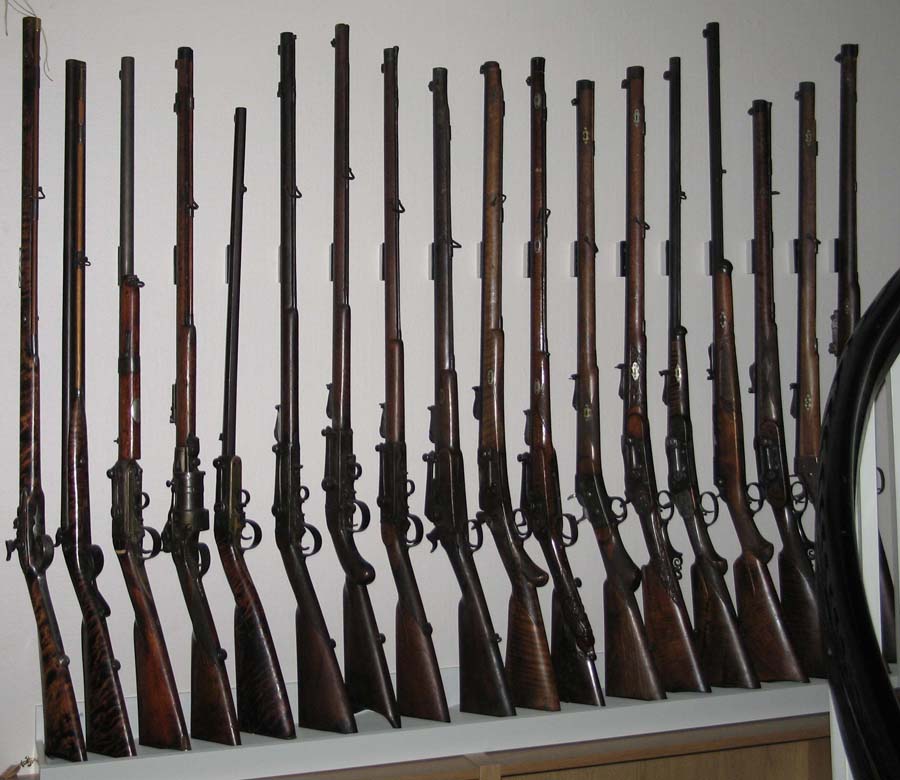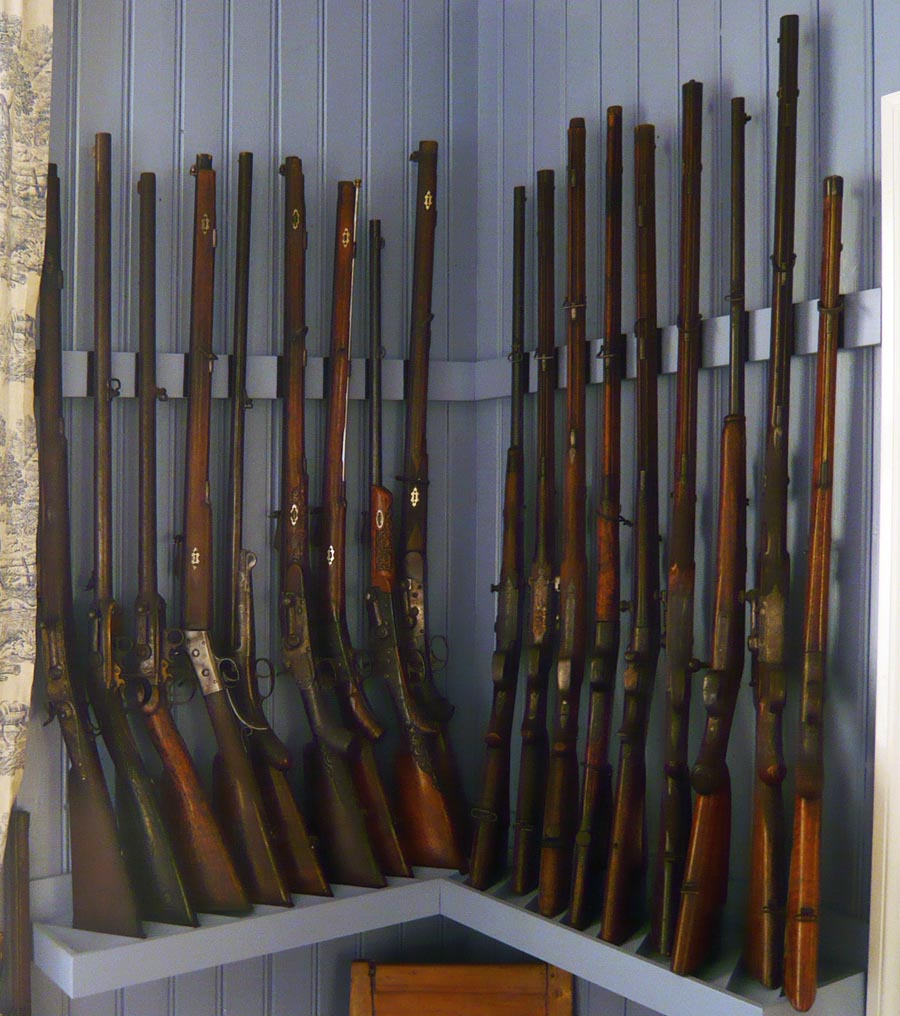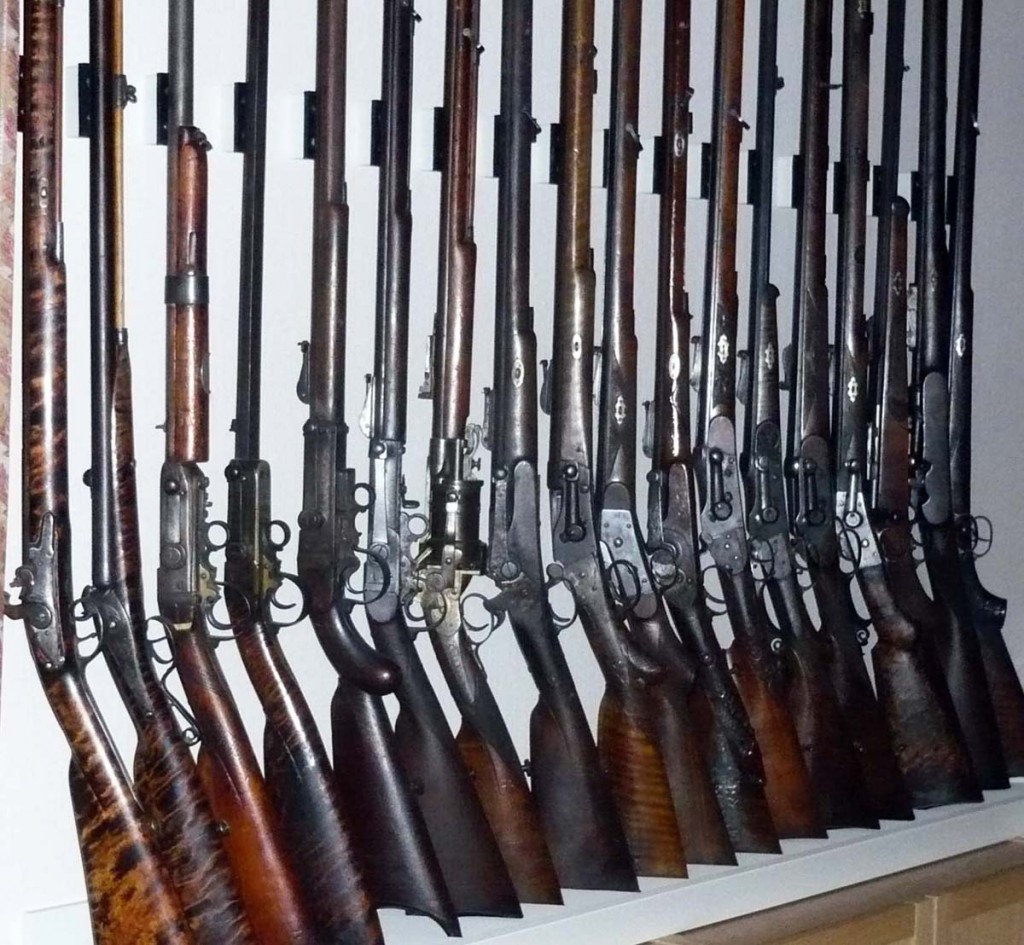My Hans Larsen collection
I’ve been a gun collector for almost 50 years, most of this time I have been concentrating on Danish/Norwegian and Norwegian long-guns, later also edged weapons and pistols, see my main collection page. Around the turn of the millennium, I was given a yearbook covering Drammen Museum 1967-1973. Most of the content covered a gunsmith from Drammen – Hans Larsen.
Mr. Larsen must really have been a fascinating and creative man, being in the right position at the right time. Hans Larsen held more than 60 patents for getting a bullet as fast and straight out of a gun as possible, some of them also covering different ways of getting the bullet in to the gun. I already owned a couple of really beautiful Larsen rifles and the reading made me want more – more information and more guns! If you want to read more about Mr. Hans Larsen, his different operations and his designs, you find more information here. On this and the following page you will find pictures and short descriptions of the different Larsen’s in my collection.
I started displaying most of my Larsen collection in our kitchen (I am one of the lucky guys with a positive wife). After a some years, the collection outgrew the space available in the kitchen and the by then almost complete series of different mechanisms was moved to out library, while duplicates and poorer conditioned ones still where in the kitchen (pic above)

The library collection as of now, consists of 18 rifles, most made by Larsen at his Drammen workshop, some from his Belgium operation. From the left: An early percussion rifle, probably from the late 1840’s/early ’50’s. The main spring has snapped so it seems to be cocked.
# 2 is a twin-barreled gun with one smooth-bore, one “straight” rifled barrel. This is probably meant for use in Sweden where you could not shoot moose unless the barrel was rifled. Thereby the straight rifled barrels that could shoot anything from shotgun pellets to moose slugs. This is probably from the mid to late 1850’s.
# 3 is a heavy, ugly kammerlader rifle. I have this in several versions – at smooth-bore and rifles.Possibly from the early to mid 1850’s.
# 4 is a neat, little kammerlader for seal hunting. Very simple, very small and really neat. More at the bottom of this page.
#5 is a beautiful kammerlader with an almost Swiss-looking rear stock. A really lovely and strange piece for having been made in Norway. Around 1860.
# 6 is a fairly similar kammerlader, but with a Norwegian type stock and a bayonet lug. The lug could never ave been used with a bayonet as the stock partly covers the lug, But the Norwegian government payed NOK 20,- for every gun with a bayonet lug – and that was a load of money at the time. From around 1860
#7 is a fascinating and unbelievably complex percussion revolver rifle, see more about this below. He patented his first revolver rifles in the late 1850’s, but this is probably one of the last made (# 14!) i the early 1860’s.
# 8 is a very well used tennstempelrifle (falling block), most probably for paper cartridge. There regretfully are parts missing and I have not been able to find the patent for this mechanism. This is probably one of the very earliest tennstempel rifles he made in the early 1860’s and there were not made many with this mechanism. I have an almost identical, but way later version, of this as # 11 in the library collection.
# 9 is also a very early tennstemperrifle from about 1865 (patent year), but this one is the true forerunner for the highly successful ones made in the 1870’s and onwards.
#10 is a lovely Remington Rolling Block, simple, sturdy and very well made in the early to mid 1870’s.
#11 is a fabulously lavish version of # 8, but with an extractor for a rim-fire cartridge. The design of the carving etc seem Swedish or Southern German, my guess is that this was made for export sometime around 1870.
#12 is a tennstempel rifle made by his Belgium operation, but sold through LH Hagen. Extreme quality of engraving and carving – a true masterpiece. More about this one on the bottom of the page.
#13 is another of the Belgium tennstempel rifles, this one half stocked and signed by Hans Larsen. Same mechanism as # 12, plenty of carving and engraving, but a completely different style.
# 14 is a strange one, except in Norway. It is a very basic Remington Rolling Block, but with a lever like the kammerladers and the tennstempel rifles. It seems a really good rifle needed a lever i the latter half of the 19th century is order to be taken seriously. This a Remington Hurtiglader (fast loader). Krank the lever and the hammer first, then the block opens. Put in the cartridge and crank it back and you are ready to fire. It really is not much faster, but a lot more – well – something – complicated?
# 15 is a seemingly brand new tennstempelrifle, where the stock is only one piece and where the hammer is placed in the sideways center of the rifle. The patent is from 1872, but fairly few with center hammers were made. It is a lovely rifle, but this one is probably made as late as in the 1880’s.
# 16 is a Schou’ patent, but I have never manages to find the patent year (or the patent) of this rather silly contraption. This i a huge, beautiful, bolt action target rifle sold through Hagen’s Christiania (Oslo) store, so it must have been from before 1886. See more about this rifle on Different Larsen’s.
# 17 is also a strange bolt-action repeating rifle with a 15(!) cartridge magazine in the butt. The mechanism is even more complex than the revolver rifle, on the other hand – this rifle has seen a lot of use, so it must have worked!
# 18 is a single action, but very similar to the repeating rifle at the bottom of the page at Different Larsen’s.
A slightly better view of the different mechanisms, click on the picture to enlarge it:
A couple of the different rifles

The Larsen percussion revolver rifle is so complex in design and mechanics that one really would believe it to be German! By pulling the lever upwards, the hammer is cocked, the cylindre retracks some 3-4 mm away from the barrel and is turned 72 degrees. When turning the lever futher – a full 360 degrees, the cylindre is moved forwards again and the chamber to be fired is “sealed” against the barrel.
How to load the rifle? No problem, you don’t even need a screwdriver. The plate in front of the cylindre is hinged and can be pulled forwards. You muzzle load one and one chamber. It’s just as the Henry from the periode: You load it on Sundays and shoot all week – ok, here you only shoot on Mondays and Tuedays.
There were probably only made a total of at most fourteen of these rifles + three prototypes. The one on the picture is possibly the very last one to be made.
If you look carefully at the top picture, you’ll see that the rifle is fitted with a bayonet lug. Well, I don’t think you could fit a bayonet on it – half the lug is covered by wood…. The idea was to receive a refund from the state as it then “could be used against the Swedes”. If it had been, I’m afraid Norway might still have been in a union with Sweden….

Chamber loaded breech loaders were the Norwegian armed forces main weapon whilst most other armies still were concidering rebuilding their flintlocks to percussion. Larsen was a bit late when designing this rifle somewhere round 1860 and these are (also) rather scarce.

Hans Larsen is most famous for two things, his accuracy in shooting and his tennstempel rifles. This is one of the really nice ones, but it is actually a Larsen produced rifle sold through Hagen and marked as a Hagen (Hagen might have done the woodwork). Extremely well fitted, lovely work and probably a magnificent shooter in its day. There still are rather many tennstempel rifles in Norway, but the really good ones are getting difficult to find. A number of Norwegian gunsmiths sold the tennstempel rifles. From the top of my head: Larsen, Eriksen, Hesselberg, Hagen, Torgersen and probably many more. As far as I can understand, just about all of them were made by Hans Larsens operation in Liege, Belgium.

